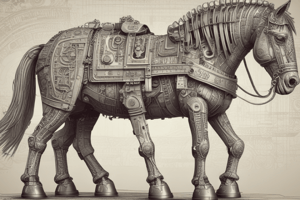Podcast
Questions and Answers
Which method does NOT directly allow malware to enter a system?
Which method does NOT directly allow malware to enter a system?
- Participating in IRC channels
- Using a secure VPN connection (correct)
- Clicking on social engineered ads
- Downloading files from untrusted sites
What is a primary function of a Trojan once it successfully infects a system?
What is a primary function of a Trojan once it successfully infects a system?
- Disabling internet connectivity
- Encrypting all files on the system
- Installing antivirus software
- Creating backdoors for remote access (correct)
Which technique involves manipulating search engine results to spread malware?
Which technique involves manipulating search engine results to spread malware?
- Malvertising
- Blackhat SEO (correct)
- Spearphishing
- Trojan propagation
Which type of malware is specifically designed to steal sensitive information by logging keystrokes?
Which type of malware is specifically designed to steal sensitive information by logging keystrokes?
Which of the following is an example of a method used to distribute malware through legitimate platforms?
Which of the following is an example of a method used to distribute malware through legitimate platforms?
Which statement best describes the function of a dropper in a Trojan packet?
Which statement best describes the function of a dropper in a Trojan packet?
What does malvertising entail?
What does malvertising entail?
Which vector is NOT commonly associated with the spread of malware?
Which vector is NOT commonly associated with the spread of malware?
What is the primary purpose of binding a Trojan executable with an innocent-looking application?
What is the primary purpose of binding a Trojan executable with an innocent-looking application?
Which statement accurately describes Remote Access Trojans?
Which statement accurately describes Remote Access Trojans?
What is a characteristic feature of Botnet Trojans?
What is a characteristic feature of Botnet Trojans?
Which method is NOT used to evade anti-virus detection for Trojans?
Which method is NOT used to evade anti-virus detection for Trojans?
How does a virus primarily spread?
How does a virus primarily spread?
What is the first stage in the life cycle of a virus?
What is the first stage in the life cycle of a virus?
Which characteristic is NOT typically associated with viruses?
Which characteristic is NOT typically associated with viruses?
What is the role of the Trojan server in Command Shell Trojans?
What is the role of the Trojan server in Command Shell Trojans?
What is a recommended practice when opening files received via email?
What is a recommended practice when opening files received via email?
Which of the following tools is specifically not mentioned as an anti-virus solution?
Which of the following tools is specifically not mentioned as an anti-virus solution?
Which of the following actions should be regularly scheduled to maintain cybersecurity?
Which of the following actions should be regularly scheduled to maintain cybersecurity?
What practice is discouraged when dealing with executable codes sent to the organization?
What practice is discouraged when dealing with executable codes sent to the organization?
What should be done with disks or programs before accepting them?
What should be done with disks or programs before accepting them?
Which method is ineffective for detecting Trojans?
Which method is ineffective for detecting Trojans?
Which countermeasure is primarily focused on user education to prevent backdoor installations?
Which countermeasure is primarily focused on user education to prevent backdoor installations?
Which of the following is NOT a category to scan for detecting Trojans?
Which of the following is NOT a category to scan for detecting Trojans?
What is the primary focus of restricting permissions within a desktop environment?
What is the primary focus of restricting permissions within a desktop environment?
Which action should be avoided to enhance security against Trojan threats?
Which action should be avoided to enhance security against Trojan threats?
What is a primary characteristic that differentiates a worm from a virus?
What is a primary characteristic that differentiates a worm from a virus?
Which of the following is NOT a reason why people create computer viruses?
Which of the following is NOT a reason why people create computer viruses?
In the context of antivirus operations, what occurs during the incorporation phase?
In the context of antivirus operations, what occurs during the incorporation phase?
How do encryption viruses evade detection by antivirus software?
How do encryption viruses evade detection by antivirus software?
What can happen once a computer worm successfully installs a backdoor?
What can happen once a computer worm successfully installs a backdoor?
What action is likely to lead to a computer being infected by a virus?
What action is likely to lead to a computer being infected by a virus?
Which statement most accurately describes the launch phase of a virus?
Which statement most accurately describes the launch phase of a virus?
What do antivirus sensor systems primarily detect?
What do antivirus sensor systems primarily detect?
Flashcards
Malware
Malware
Malicious software designed to damage or disable computer systems, or give unauthorized access to the creator.
Trojan Horse
Trojan Horse
A type of malware disguised as legitimate software to trick users into installing it.
Malware Distribution Techniques
Malware Distribution Techniques
Methods used by attackers to spread malware, including social engineering, compromised websites, and malicious advertisements.
Trojan Functionality
Trojan Functionality
Signup and view all the flashcards
Malvertising
Malvertising
Signup and view all the flashcards
Drive-by Download
Drive-by Download
Signup and view all the flashcards
Social Engineered Click-jacking
Social Engineered Click-jacking
Signup and view all the flashcards
Backdoor
Backdoor
Signup and view all the flashcards
Trojan Wrapper
Trojan Wrapper
Signup and view all the flashcards
Command Shell Trojan
Command Shell Trojan
Signup and view all the flashcards
Remote Access Trojan (RAT)
Remote Access Trojan (RAT)
Signup and view all the flashcards
Botnet Trojan
Botnet Trojan
Signup and view all the flashcards
Antivirus Evasion Technique
Antivirus Evasion Technique
Signup and view all the flashcards
Virus Self-Replication
Virus Self-Replication
Signup and view all the flashcards
Virus Infection Method
Virus Infection Method
Signup and view all the flashcards
Virus Characteristics
Virus Characteristics
Signup and view all the flashcards
Identifying Trojans
Identifying Trojans
Signup and view all the flashcards
Trojan Countermeasures
Trojan Countermeasures
Signup and view all the flashcards
Suspect File Activity
Suspect File Activity
Signup and view all the flashcards
Network Monitoring
Network Monitoring
Signup and view all the flashcards
Anti-virus Software
Anti-virus Software
Signup and view all the flashcards
Computer Virus Replication
Computer Virus Replication
Signup and view all the flashcards
Computer Virus Launch
Computer Virus Launch
Signup and view all the flashcards
Computer Virus Detection
Computer Virus Detection
Signup and view all the flashcards
Computer Virus Incorporation
Computer Virus Incorporation
Signup and view all the flashcards
Computer Worm Replication
Computer Worm Replication
Signup and view all the flashcards
Worm vs. Virus
Worm vs. Virus
Signup and view all the flashcards
Encryption Virus
Encryption Virus
Signup and view all the flashcards
Antivirus Sensor Systems
Antivirus Sensor Systems
Signup and view all the flashcards
Anti-virus Software Use
Anti-virus Software Use
Signup and view all the flashcards
Regular Anti-virus Updates
Regular Anti-virus Updates
Signup and view all the flashcards
Why Is Data Backup Important?
Why Is Data Backup Important?
Signup and view all the flashcards
Executable Code Approval
Executable Code Approval
Signup and view all the flashcards
Firewall Use
Firewall Use
Signup and view all the flashcards
Study Notes
Malware Threats
- Malware is malicious software that damages or disables computer systems, granting limited or full control to the creator for theft or fraud.
Examples of Malware
- Trojan Horse
- Virus
- Backdoor
- Worms
- Rootkit
- Spyware
- Ransomware
- Botnet
- Adware
- Crypter
Different Ways Malware Enters a System
- Instant messenger applications
- Browser and email software bugs
- IRC (Internet Relay Chat)
- Removable devices
- Attachments
- NetBIOS (File Sharing)
- Fake programs
- Untrusted sites and freeware software
- Downloading files, games, and screensavers from Internet sites
- Legitimate "shrink-wrapped" software packaged by a disgruntled employee
Common Techniques Attackers Use to Distribute Malware on the Web
- Blackhat Search Engine Optimization (SEO)
- Ranking malware pages highly in search results
- Social Engineered
- Click-jacking
- Tricking users into clicking on innocent-looking webpages
- Malvertising
- Embedding malware in ad-networks that display across hundreds of legitimate, high-traffic sites
- Spearphishing Sites
- Mimicking legitimate institutions to steal login credentials
- Compromised Legitimate Websites
- Hosting embedded malware that spreads to unsuspecting visitors
- Drive-by Downloads
- Exploiting browser flaws to install malware by visiting a webpage
How Hackers Use Trojans
- Delete or replace operating system critical files
- Disable firewalls and antivirus
- Generate fake traffic to create DOS attacks
- Record screenshots, audio, and video of victim's PC
- Use victim's PC for spamming and email blasting
- Download spyware, adware, and malicious files
How to Infect Systems Using a Trojan (Part 1)
- Creating a new Trojan packet with a Trojan Horse Construction Kit
- Constructing a dropper, part of a trojanized packet to install malicious code on the target system
How To Infect Systems Using a Trojan (Part 2)
- Create a wrapper using wrapper tools to install a Trojan on the victim's computer
- Propagate the Trojan
- Execute the dropper
- Execute the damage routine
Wrappers
- Combine a Trojan executable with an innocent-looking application, such as game or office applications.
- Trojan installations happen in the background while a seemingly harmless application runs in the foreground
- Attackers might send a birthday greeting that simultaneously installs a Trojan.
- The two programs are packaged into a single file.
Command Shell Trojans
- Remotely control a command shell on the victim's machine.
- A Trojan server is installed on the victim's machine, opening a port for attacker connection.
- A client is installed on the attacker's machine to launch a command shell on the victim's machine.
Remote Access Trojans
- This remote desktop access Trojan allows the attacker to access the victim's machine remotely.
- The attacker gains complete GUI access to the victim's remote system.
Botnet Trojans
- Infects a large number of computers geographically to create a network of bots.
- Controlled by a command and control (C&C) center
- Botnet is used to launch various attacks on a victim. Includes denial-of-service attacks, spam, click fraud, and theft or financial information.
Evading Anti-Virus Techniques
- Break the Trojan file into multiple pieces and zip them as a single file.
- Always create and embed a Trojan into an application.
- Change Trojan syntax (convert EXE to VB script, change extensions like EXE to DOC.EXE, PPT.EXE, or PDF.EXE)
- Change Trojan contents using Hex Editor and change checksum and encrypt the file.
- Download Trojans from untrusted sources (anti-virus software usually detects these).
Introduction to Viruses
- A virus is a self-replicating program that attaches itself to other programs or documents on a computer system.
- Viruses are transmitted through file downloads, infected disks, flash drives, and email attachments.
Virus Characteristics
- Infects other programs
- Alters data
- Transforms itself
- Corrupts files and programs
- Encrypts itself;
- Self-replicates
Stages of Virus Life
- Design (develop virus code using programming languages or construction kits)
- Replication (virus replicates and spreads within the target system)
- Launch (activation by the user)
- Detection (virus is identified)
- Incorporation (antivirus developers assimilate defenses)
- Elimination (users install updates to eliminate threats)
Reasons People Create Computer Viruses
- Inflict damage to competitors
- Financial benefits
- Research projects
- Play pranks
- Vandalism
- Cyber terrorism
- Distribute political messages
How a Computer Gets Infected by Viruses
- User accepts files and downloads without source verification
- Opening infected email attachments
- Installing pirated software
- Not updating or installing new plug-ins
- Not running the latest anti-virus software
Encryption Viruses
- Encrypts the code within an infected file using encryption keys for each file.
- Anti-virus scanner cannot directly detect these encryption viruses using standard signature detection methods
Computer Worms
- Malicious programs that replicate, execute, and spread across networks without human intervention.
- Most worms are created to replicate and spread through computer resources, while some contain payloads designed to damage the target.
- Attackers use worm payload to install backdoors in infected computers (zombie) and create botnets to perform larger attacks.
How a Worm Differs From a Virus
- Worms replicate on their own, using system resources
- Worms can spread across networks through information transportation features
- Worms do not attach to other files or programs but replicate independently.
Anti-Virus Sensor Systems
- Collection of software that detects and analyzes malicious code threats (viruses, worms, Trojans)
- Used along with secure computers, filtering network traffic and email
- Includes anti-virus, anti-spyware, anti-trojan, anti-spamware, anti-phishing, and email scanners
How to Detect Trojans
- Scan for suspicious open ports
- Scan for suspicious startup programs
- Scan for suspicious running processes
- Scan for suspicious files and folders
- Scan for suspicious registry entries
- Scan for suspicious network activities
- Scan for suspicious device drivers installed on the computer
- Scan for suspicious Windows services
- Run Trojan scanner
Trojan Countermeasures
- Avoid opening email attachments from unknown senders
- Install patches and security updates
- Block unnecessary ports and use a firewall
- Avoid accepting programs sent through instant messages
- Harden default configuration settings
- Monitor internal network traffic
- Scan CDs and DVDs with antivirus software
- Restrict permissions in the desktop environment
- Avoid commands blindly
- Manage local workstation file integrity
- Avoid downloading/executing applications from untrusted sources
- Run host-based antivirus, firewall, and intrusion detection software
Backdoor Countermeasures
- Most commercial anti-virus products automatically scan for and detect backdoor programs.
- Educate users about downloading applications from untrusted sources
- Use anti-virus tools such as McAfee, Norton, etc to eliminate backdoors
Virus and Worms Countermeasures
- Install anti-virus software
- Pay attention to instructions during downloads
- Avoid opening attachments from unknown senders
- Regularly update anti-virus software
- Regularly back up data
- Do not accept disks or programs without checking using updated anti-virus
- Ensure the executable code sent to the organization is approved
- Do not boot the machine with infected bootable disk
- Know about latest virus threats
- Check DVDs and CDs for infection
- Ensure pop-up blocker and internet firewall is on
Anti-virus Tools
(List of anti-virus tools provided)
Studying That Suits You
Use AI to generate personalized quizzes and flashcards to suit your learning preferences.




